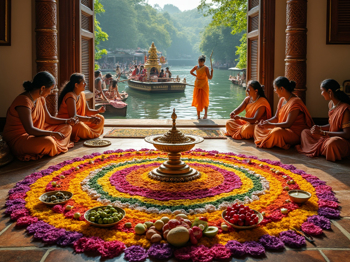The puja (ritual worship) performed during Onam holds deep spiritual and cultural significance. It is a way of honoring King Mahabali and the divine blessings of Lord Vishnu, who took the Vamana avatar to humble the king's pride. The puja embodies the values of humility, gratitude, and communal harmony. It serves as a reminder of the legendary king's just and prosperous reign, inspiring people to cultivate virtues such as generosity, honesty, and unity in their lives.
- Spiritual Blessings: Performing the Onam Puja invokes the blessings of Lord Vishnu and King Mahabali, believed to bring prosperity, peace, and happiness to the family.
- Cultural Preservation: Engaging in the traditional rituals and practices of Onam Puja helps preserve Kerala's rich cultural heritage and passes it on to future generations.
- Community Bonding: The communal aspect of the puja fosters a sense of unity and togetherness among families, neighbors, and communities, reinforcing social bonds.
- Reflection and Gratitude: The puja encourages reflection on the values of humility, gratitude, and selflessness, helping individuals cultivate a positive mindset.
- Renewal of Traditions: Participating in the puja allows individuals to renew their connection to their cultural roots, reinforcing their identity and traditions.
- Spiritual Cleansing: The rituals performed during the puja are believed to purify the mind and soul, promoting inner peace and spiritual well-being.
Onam is a major festival celebrated primarily in the Indian state of Kerala. It marks the homecoming of the mythical King Mahabali and is a time of grand feasts, traditional dances, and cultural performances. The celebration lasts for ten days, each day having its significance. Below is a step-by-step guide to performing Onam:
1. Start with Atham (First Day)
- Pookalam (Floral Rangoli): Begin creating a Pookalam, a floral carpet, on the ground at the entrance of your home. It starts small on Atham and grows larger each day until the final day of Onam. Use fresh flowers and make intricate designs.
- Cleaning and Decoration: Clean and decorate your house. Traditionally, people hang floral garlands and decorate with traditional lamps.
2. Daily Rituals (Days 2 to 8)
- Continue the Pookalam: Each day, add new layers and designs to the Pookalam. It symbolizes the prosperity brought by King Mahabali.
- Traditional Attire: Wear traditional Kerala attire. Women often wear Kasavu sarees, and men wear Mundu (a type of dhoti).
- Cultural Activities: Participate in or organize cultural activities like folk dances (Thiruvathirakali), music, and games like Vallamkali (boat race) and Pulikali (tiger dance).
3. Uthradam (9th Day)
- Preparation for Onam: This day is considered the eve of Onam. Clean your house thoroughly, as it is believed that King Mahabali visits every household on this day.
- Shopping: Purchase fresh vegetables, fruits, and other essentials for the grand feast (Onasadya) to be prepared the next day.
- Visit Local Markets: Traditionally, this day is also associated with visiting local markets for purchasing new clothes, known as Onakkodi.
4. Thiruvonam (10th Day)
- Pookalam Final Touch: Complete the Pookalam with final touches. This is the grandest and most elaborate design.
- Early Morning Rituals:
- Take a ritualistic bath early in the morning.
- Offer prayers in the family puja room or at a temple. Anointing oneself with sesame oil before the bath is also a common practice.
- Onasadya (Grand Feast):
- Preparation: Start preparing the Onasadya, a multi-course vegetarian meal served on a banana leaf. It typically includes dishes like rice, sambar, avial, thoran, olan, pickles, pappadam, payasam (dessert), and more.
- Serving: Onasadya is traditionally served at lunch. The meal is enjoyed together with family and guests.
- Cultural Programs: After the feast, people participate in or watch cultural programs, including dance, music, and games.
- Exchange of Gifts: It's customary to exchange gifts, especially new clothes and sweets, among family members and friends.
5. Post-Onam Celebrations (Avittam and Chatayam)
- Removing the Pookalam: On Avittam, the eleventh day, the Pookalam is ceremonially removed.
- Onathappan Statue: Some households remove the clay statue of Onathappan, which is placed in the middle of the Pookalam during the festival, symbolizing the departure of King Mahabali.
- Kalyanam and Kali: On Chatayam, the final day, cultural events and performances continue in some regions, especially in temples and community centers.
6. Community Involvement
- Participate in local events organized by your community. Many villages and towns host grand celebrations, including boat races, flower shows, and folk art performances.
7. Concluding the Festival
- Visiting Relatives: Post-Onam, visit relatives and friends if not done earlier. Share sweets and festive greetings.
- Thanksgiving: End the festival with prayers of thanksgiving, acknowledging the blessings and prosperity received during the year.
Onam is not just a festival but a cultural celebration that embodies the spirit of unity, joy, and prosperity. By following these steps, you can immerse yourself in the rich traditions and festivities of Onam.




